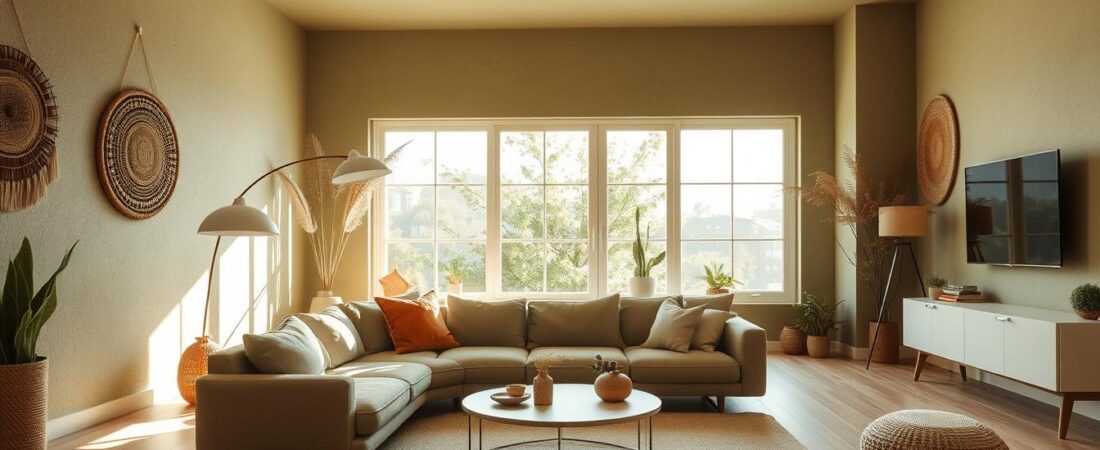As we enter 2025, the interior design world is full of exciting trends. These trends aim to make our homes stylish and eco-friendly. They include bold colors, sustainable materials, and furniture that does more than one thing.
The home decor trends 2025 focus on making spaces both beautiful and useful. They emphasize sustainability and new design ideas. These trends will change how we live and enjoy our homes.
Key Takeaways
- Bold colors will dominate the interior design scene in 2025.
- Sustainable materials will be a key feature in home decor.
- Multifunctional furniture will become increasingly popular.
- Home decor will focus on creating functional and beautiful spaces.
- Eco-friendly design will be a major trend in 2025.
Forecasting Home Design: What’s New for 2025
The pandemic has changed how we design homes. In 2025, homes will be both beautiful and practical. They will also be good for the planet. The future home design trends focus on being ready for anything.
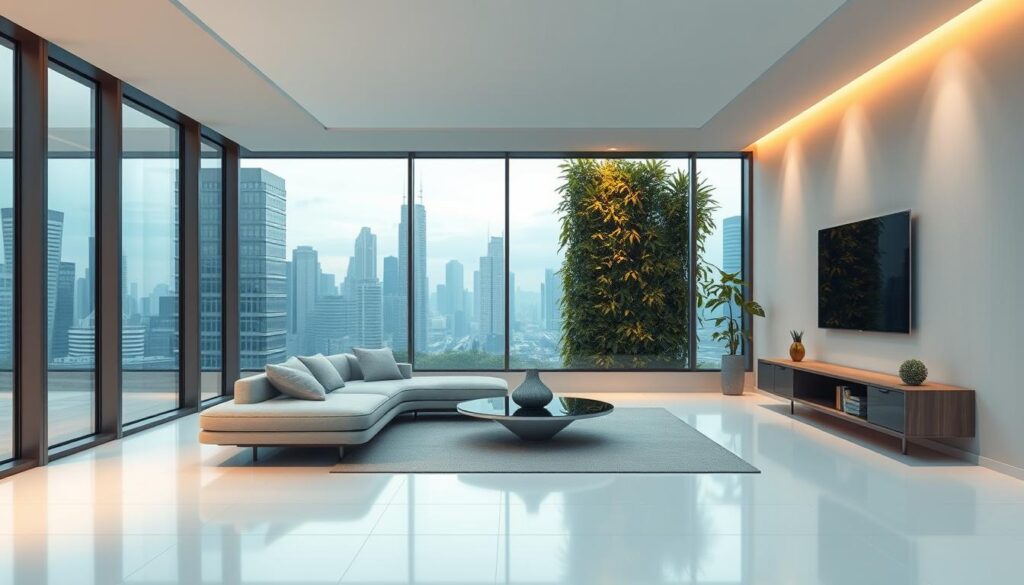
The Evolution of Post-Pandemic Living Spaces
The pandemic has changed how we see our homes. Now, homes are more than just places to sleep. They are places for work, fun, and staying healthy. This has led to a need for upcoming interior design styles that meet all these needs.
Designers are making spaces that can change with our needs. They add things like home offices, gyms, and areas for meditation. This makes homes more useful and flexible.
How Economic and Environmental Factors Are Shaping Design
Economic and environmental issues are big in 2025’s design. People care more about the planet, so designs are getting greener. This means using materials that are good for the earth and systems that save energy.
Money matters too. People want designs that are affordable but don’t look cheap. This has made multifunctional furniture and recycled materials popular. It’s about getting value without sacrificing style.
Looking ahead to 2025, design is influenced by many things. By understanding these trends, we can make homes that are not just pretty. They will also be good for the planet, useful, and ready for the future.
The 2025 Interior Design Trends You’ll Want in Your Home
2025 is bringing new interior design trends that will make homes cozy and stylish. We’re excited to see how our living spaces will change. It’s important to know the main trends that will shape our homes.
Major Trend Directions for the Coming Year
The design world in 2025 will mix sustainability, technology, and beauty. Key trends include:
- Sustainable Materials: Homes will use more recycled and regenerative materials, making them greener.
- Smart Home Integration: Our homes will get smarter with AI systems, making life easier and more efficient.
- Biophilic Design: We’ll see more of nature in our homes, like living walls and natural materials.
Let’s look at how home decor materials might change in 2025:
| Material | 2024 Usage | 2025 Projected Usage |
|---|---|---|
| Recycled Wood | 20% | 30% |
| Sustainable Fabrics | 15% | 25% |
| Low-VOC Paints | 40% | 50% |
Balancing Timelessness with Trendy Elements
It’s fun to follow the latest trends, but we must also keep things timeless. This way, our homes won’t look old-fashioned soon. Here are some tips:
- Invest in Timeless Furniture: Pick classic pieces that won’t go out of style quickly.
- Use Trendy Accents: Update your decor with trendy items like throw pillows, rugs, and wall art. These are easy to swap out.
- Blend Old and New: Mix vintage or antique items with modern ones for a unique look that lasts.
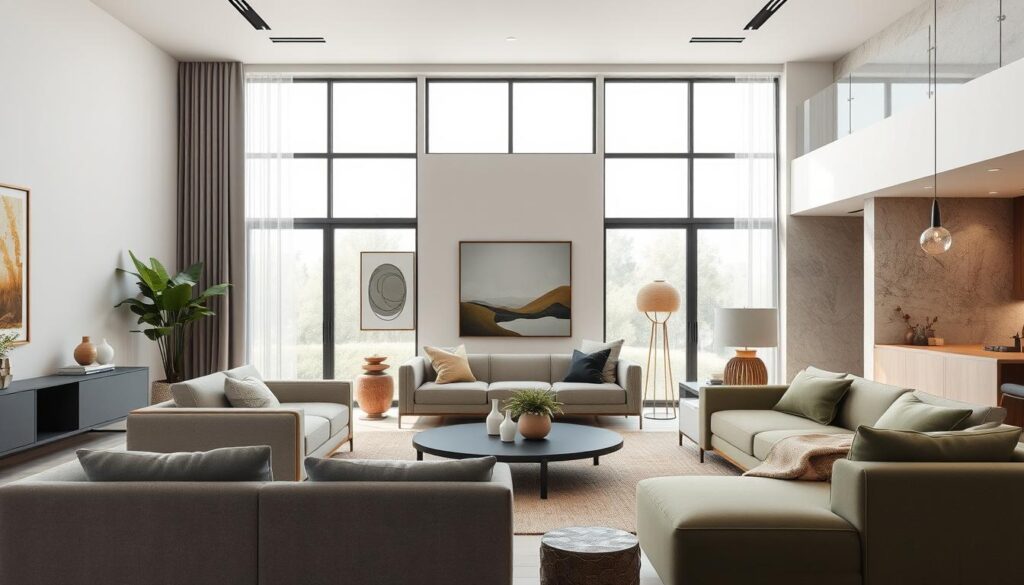
By knowing the 2025 trends and balancing them with timeless pieces, we can make our homes stylish and practical. Whether you’re updating one room or redoing your whole house, these tips will help. They’ll ensure your space reflects your style and meets your needs.
Biophilic Design: The Nature-Connected Home
Biophilic design is changing how we see our homes. It brings nature inside to make our living spaces better. This approach helps us feel better and live more sustainably.
Living Walls and Integrated Indoor Gardens
Living walls and indoor gardens are key in biophilic design. They clean the air and make us feel calm. Living walls can be made in many ways, like with hydroponics or regular soil.
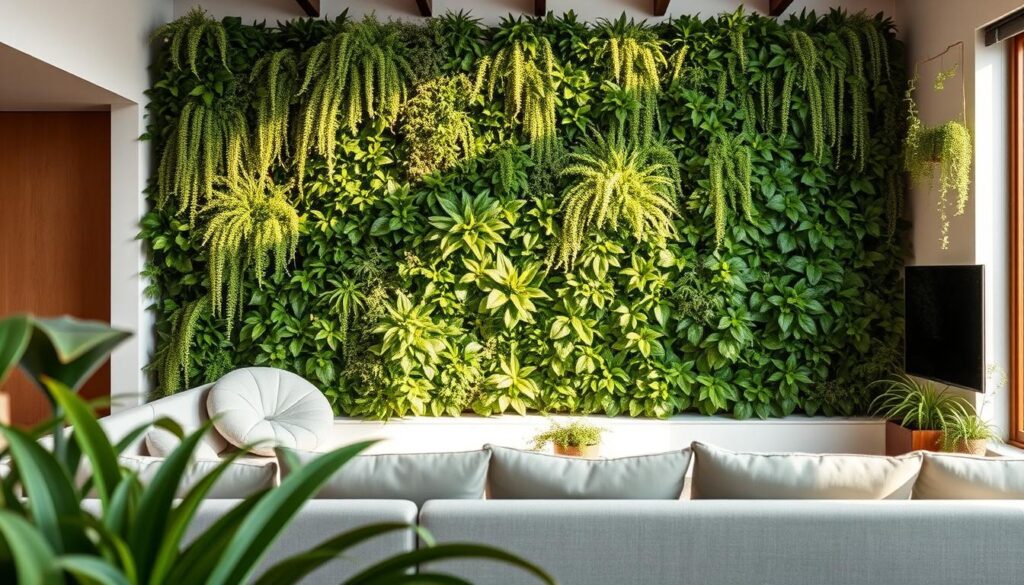
Indoor gardens can be small, like a kitchen herb garden, or big, like a greenhouse. They help us feel close to nature, even in cities.
Natural Materials: Stone, Wood, and Plant-Based Textiles
Using natural materials is at the heart of biophilic design. Stone, wood, and plant-based textiles add warmth and texture. They make spaces feel welcoming and are good for our health.
- Stone: Adds a sense of solidity and permanence
- Wood: Brings warmth and can be sustainably sourced
- Plant-Based Textiles: Offers innovative, eco-friendly alternatives to traditional materials
Organic Shapes and Nature-Inspired Forms
Biophilic design loves organic shapes and nature-inspired designs. It moves away from straight lines to curves and patterns found in nature. This can be seen in furniture and decorations.
By using these elements, homes become more connected to nature. This improves our overall well-being.
Smart Home Integration 2.0
Smart Home Integration 2.0 is changing how we live and work at home. It makes our homes more efficient and green. This new tech uses AI, integrates well with other systems, and manages energy smartly.
AI-Powered Home Systems and Wellness Technology
AI is making homes more comfortable and secure. It learns our habits to save energy and improve efficiency. This tech makes our homes work better for us.
Wellness tech is key in Smart Home 2.0. It includes air quality checks, water filters, and smart lights that feel like natural light. These features help keep our homes healthy.
“The future of smart homes lies in their ability to integrate technology seamlessly into our daily lives, enriching our well-being and productivity.” –
Invisible Tech: Seamlessly Integrated Smart Solutions
“Invisible Tech” means smart solutions that blend into our homes. This includes voice control, automated blinds, and remote security systems. These features make tech less noticeable and easier to use.
- Voice-controlled lighting and temperature control
- Automated security systems with facial recognition
- Smart home entertainment systems integrated with AI assistants

Energy Management Systems for the Modern Home
Energy management is vital in Smart Home 2.0. Advanced systems track and control energy use in real-time. They help save energy and can work with solar power to cut down on carbon emissions.
| Feature | Description | Benefit |
|---|---|---|
| Real-time Energy Monitoring | Monitors energy usage in real-time | Identifies areas of inefficiency |
| Automated Energy Optimization | Optimizes energy consumption based on household routines | Reduces energy waste and lowers bills |
| Integration with Renewable Energy | Integrates with solar panels and other renewable sources | Reduces carbon footprint |
As Smart Home Integration 2.0 grows, we’ll see more cool tech. Our homes will become even more comfy, efficient, and eco-friendly.
Sustainable and Circular Design Practices
The year 2025 will change interior design with a focus on sustainable and circular design practices. People are now looking for eco-friendly options. These choices help the environment and make homes healthier.
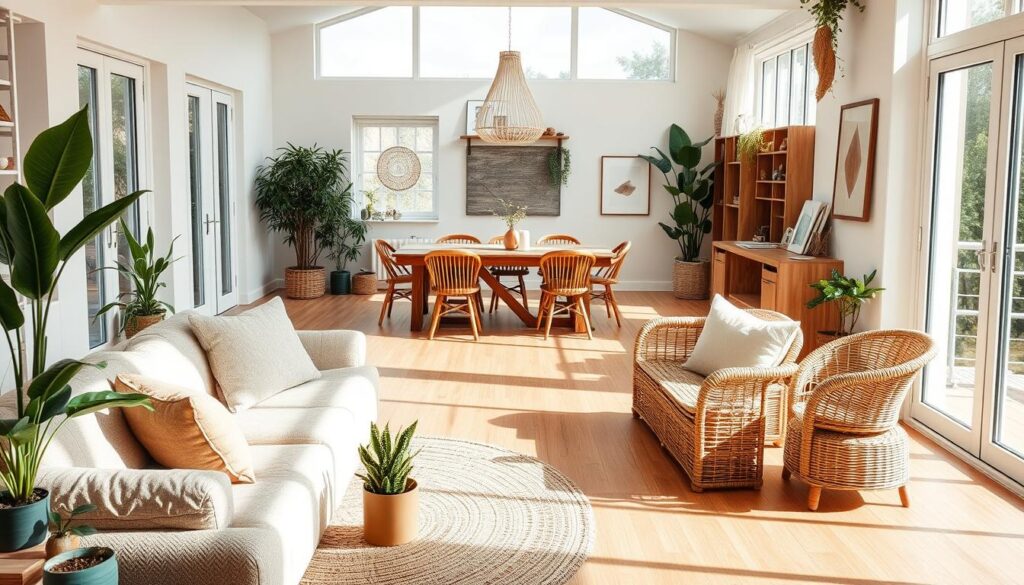
Recycled and Regenerative Materials Taking Center Stage
Recycled and regenerative materials are becoming key in home decor. These include materials reused from before and those that grow back naturally. Think of reclaimed wood, recycled glass, and plant-based fabrics.
Designers are using these materials in creative ways. They’re making furniture, decor, and even parts of homes out of them. This trend is good for the planet and makes homes more interesting.
Water Conservation Through Innovative Design
Water conservation is a big part of sustainable design. New ideas like low-flow fixtures and greywater systems are showing up. They help save water and use it wisely.
- Low-flow showerheads and faucets
- Dual-flush toilets
- Rainwater harvesting systems
Carbon-Neutral and Climate-Positive Home Elements
Designers are aiming for carbon-neutral or even climate-positive homes. They choose materials with low carbon footprints. They also add things that help lower CO2 levels.
Using materials that absorb carbon, adding plants, and renewable energy systems are examples. These actions are good for the planet and improve home life.
Color Palettes and Material Trends for 2025
Interior designers are excited for 2025. They’re mixing technology with nature in color palettes and materials. This new mix promises a fresh era in home decor, blending sustainability with innovation.
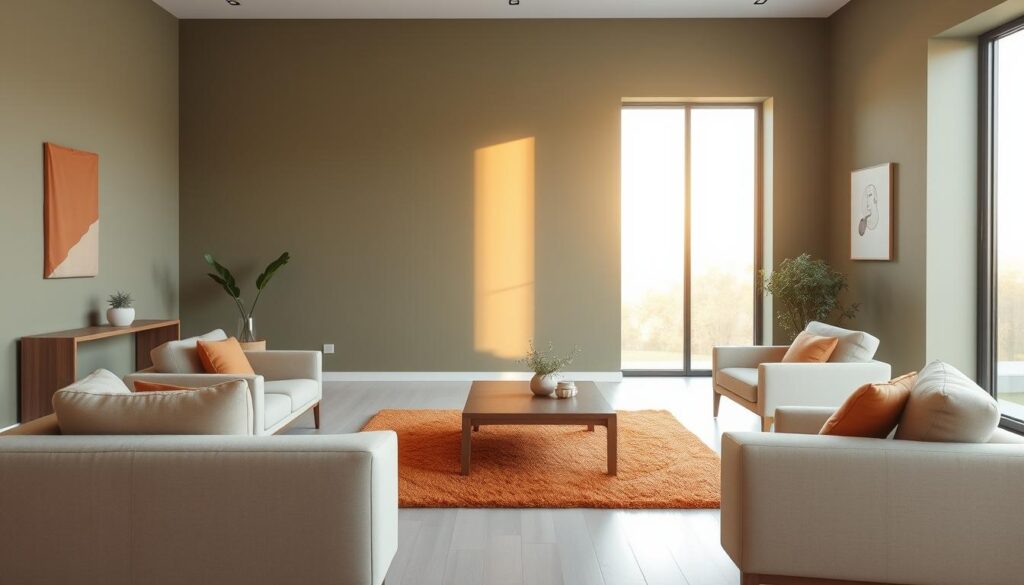
Earth Tones with Digital-Age Accents
For 2025, earthy tones like terracotta, sage green, and sandy beige are in. They’re paired with modern metallics like rose gold and chrome. This mix brings warmth and modernity together.
Earth tones offer comfort and grounding. Metallic accents add sophistication and a futuristic feel. This combination is ideal for a cozy yet modern home.
Textural Contrasts: Matte, Gloss, and Dimensional Surfaces
Texture is key in 2025 interior design. Expect to see matte, gloss, and dimensional surfaces. This mix adds depth and interest to rooms.
- Matte finishes offer a calm, subtle look.
- Glossy surfaces add shine and elegance.
- Dimensional surfaces add texture and intrigue.
As interior design expert Jane Smith says, “The secret to textural contrasts is finding balance. You want to engage without overwhelming.”
Metals and Metallics: From Warm Brass to Cool Chrome
Metallic accents are back in 2025, adding glamour to interiors. Warm brass and cool chrome are used in lighting, hardware, and decor.
“Metallic accents can instantly elevate a room, adding sophistication and style. The choice of metal greatly affects the ambiance, with warm tones creating coziness and cool tones adding modernity.”
Metallics are versatile, fitting any design style. They’re a valuable tool in interior design.
Furniture and Layout Evolution
Furniture and layout are changing in 2025. They are becoming more versatile and stylish. Homes are now more than just places to live; they are spaces for many activities.
Multifunctional and Transformable Furniture Solutions
In 2025, furniture that does more than one thing is popular. People want furniture that saves space but looks good. Think of sofa beds, storage ottomans, and tables that grow bigger when needed.
Key Features of Multifunctional Furniture:
- Space-saving designs
- Modular components
- Convertible functions
Curves and Organic Forms Replacing Straight Lines
Curved lines and organic shapes are becoming trendy in 2025. They make rooms feel softer and more welcoming. Furniture with rounded edges brings a cozy feel to any home.
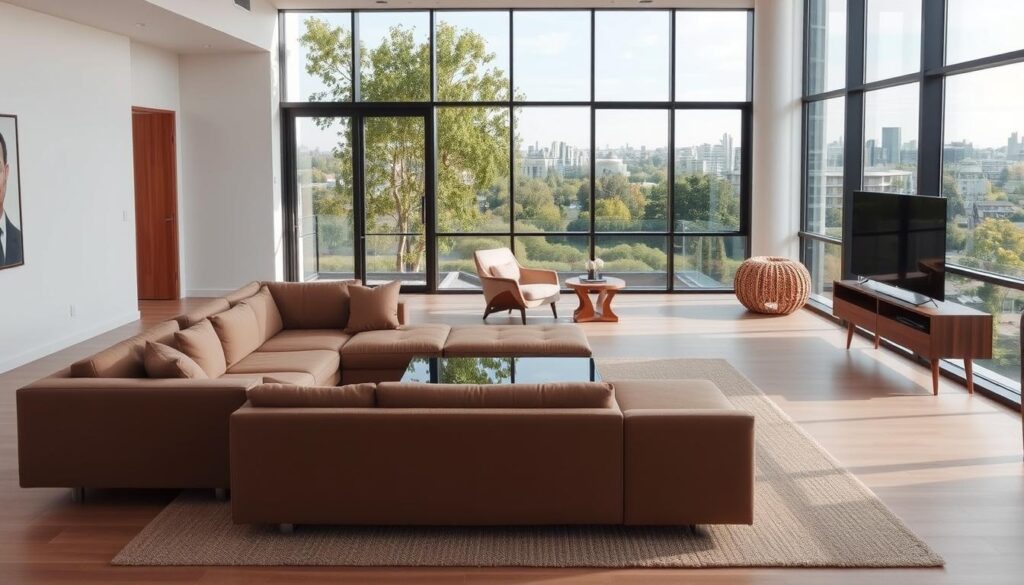
Statement Pieces: Artistic Furniture as Focal Points
In 2025, standout furniture pieces are the stars of the room. They show off personal style and add character. From unique chairs to bold sofas, these pieces are changing how we design interiors.
Characteristics of Statement Furniture:
| Feature | Description | Example |
|---|---|---|
| Unique Design | One-of-a-kind or limited edition pieces | Sculptural chairs |
| Bold Colors | Vibrant hues that stand out | Brightly colored sofas |
| Artistic Expression | Furniture as art, often handmade | Handcrafted wooden tables |
These trends show that the future of interior design is about beauty, function, and personal touch. It’s about creating spaces that are both beautiful and practical.
Room-Specific Trends for 2025
As we enter 2025, home design is changing a lot. People want their homes to look good and work well. This means making each room special and useful.
Kitchen Innovations: Beyond the Traditional Workspace
The kitchen is becoming more than just a place to cook. In 2025, kitchens will have new tech, be green, and do more things. Smart kitchens and eco-friendly materials are big this year.
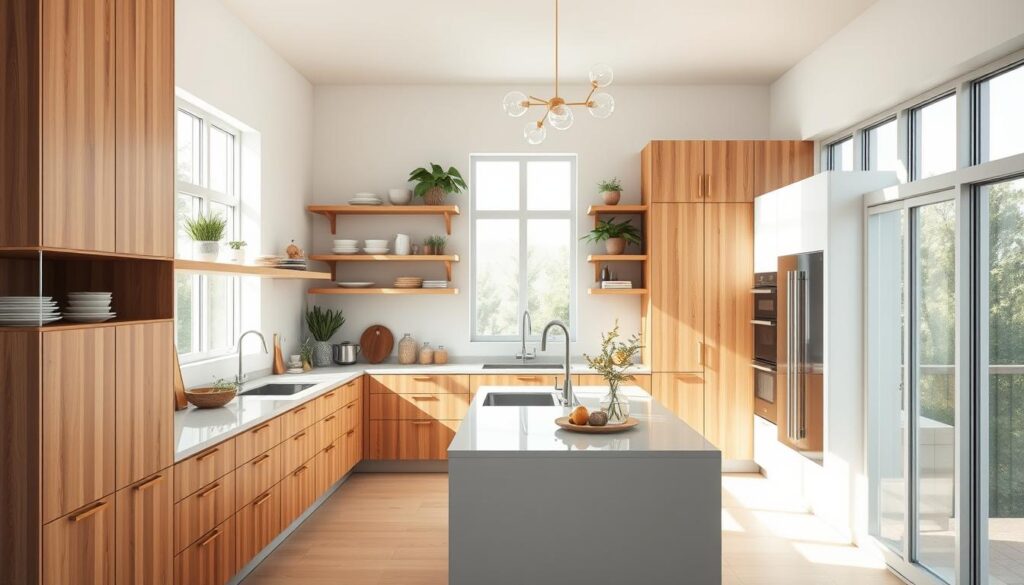
| Feature | Description | Benefit |
|---|---|---|
| Smart Appliances | Integrated with AI for efficient cooking | Saves time and energy |
| Sustainable Materials | Recycled and eco-friendly materials used | Reduces environmental impact |
| Multifunctional Islands | Serves as cooking, dining, and storage space | Enhances kitchen functionality |
Bathroom Transformations: Spa-Like Retreats
Bathrooms in 2025 will feel like spas. They’ll have features like rain showerheads and heated floors. Wellness-oriented design and calming color schemes are key.
Reimagined Home Offices and Multipurpose Spaces
Remote work is making home offices more common. In 2025, homes will have multipurpose spaces for work, study, or fun. Flexible furniture and ergonomic design are important.
Global Design Influences and Cultural Fusion
The interior design for 2025 is a mix of global styles. It combines old crafts with new looks. This mix creates spaces that share stories and feelings.
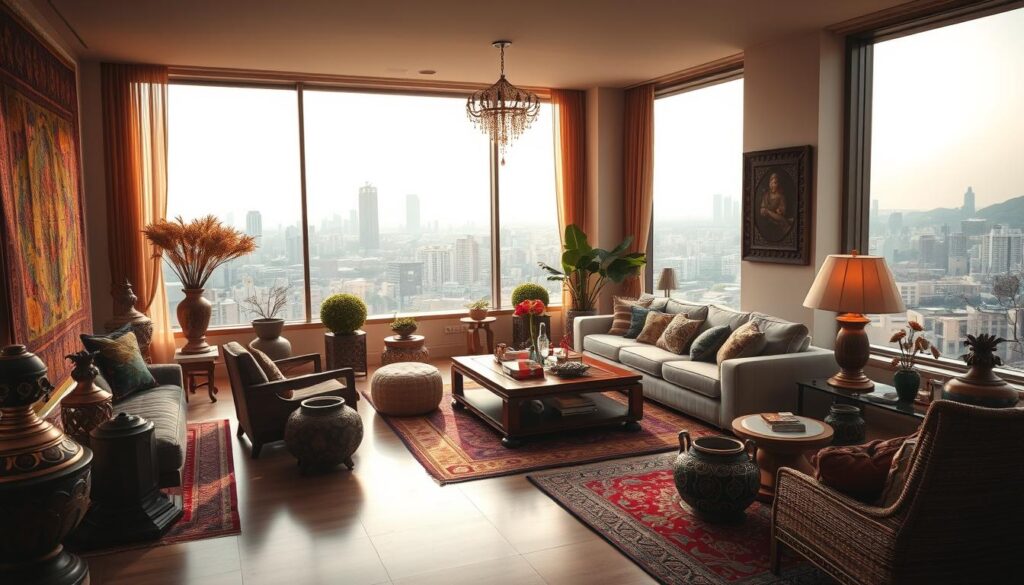
Heritage Crafts Meeting Modern Aesthetics
Heritage crafts are back in 2025. Designers and artisans are mixing old skills with new ideas. This mix is seen in:
- Handwoven textiles with modern patterns and materials
- Ceramics and pottery that use old techniques in new shapes
- Woodwork that mixes old skills with modern looks
Regional Design Elements Going Global
Designs from around the world are becoming famous. This is thanks to easy sharing of ideas and a connected design community. Some notable elements include:
- Scandinavian minimalism, known for its simplicity and usefulness
- Moroccan patterns and textiles, famous for their bright colors and detailed designs
- Indian block printing, a traditional method used in today’s decor
Artisanal and Handcrafted Touches in Mass Production
More people want unique, handmade items, even in mass-produced goods. This desire is for products with stories. Designers are adding handmade touches to their work, like:
- Hand-painted ceramics
- Custom, hand-woven rugs
- Artisanal lighting that combines old skills with new materials
In 2025, global design trends and cultural fusion will keep changing our homes. They will make our spaces more varied, rich, and personal.
Conclusion: Creating a Future-Ready Home That Reflects Your Style
Looking ahead to 2025, we see new trends in interior design. These can make your home better. To make your home future-ready and stylish, think about what we’ve talked about.
Begin with biophilic design. Use natural materials and shapes. Mix timeless pieces with the latest trends. Add unique items that show who you are.
Using these trends, your home will be stylish and useful. Your home should show your style. So, enjoy designing and make it yours.
